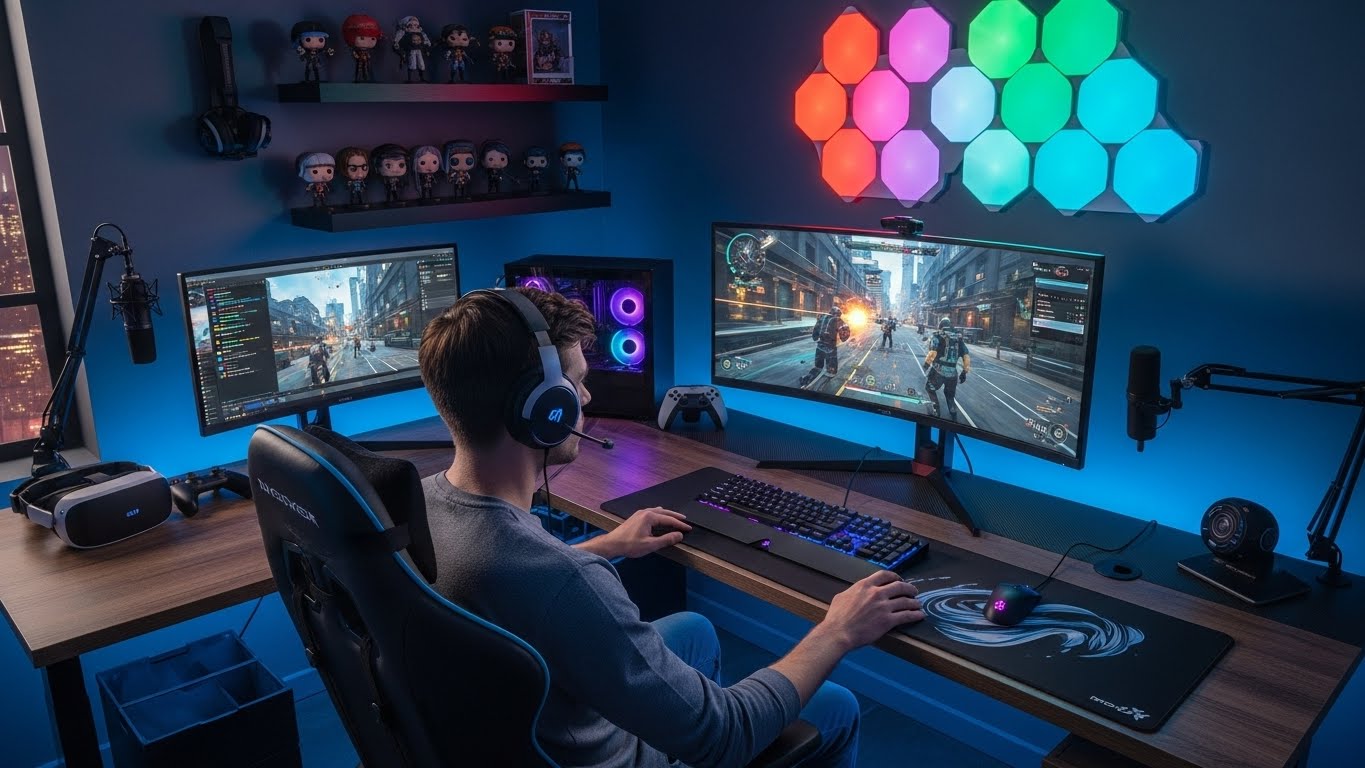Gaming has come a long way since its inception, evolving from simple pixelated forms of entertainment into fully immersive digital universes that captivate millions around the world. This journey has been marked by innovation, cultural shifts, and technological breakthroughs, transforming gaming into one of the most influential mediums of the 21st century. In this blog post, we will explore the evolution of gaming, its cultural impact, the rise of competitive gaming, technological advancements, and what the future might hold for gamers everywhere.
Early Beginnings of Video Games
The story of gaming begins in the 1950s and 1960s, a period when computers were primarily large, inaccessible machines used for research and calculations. The first known interactive electronic game was created in 1958 by William Higinbotham, called Tennis for Two. This rudimentary game simulated a tennis match on an oscilloscope screen, sparking curiosity and excitement in a world largely unfamiliar with electronic entertainment.
Following this, the 1970s witnessed the rise of arcade games. Pong, developed by Atari in 1972, became the first commercially successful video game. Its simplicity—just two paddles and a bouncing ball—was revolutionary for the time. People flocked to arcades, fascinated by the novelty of interactive gameplay, setting the stage for a booming industry.
The Home Console Revolution
While arcades dominated early gaming, the late 1970s and early 1980s saw the advent of home consoles. Devices like the Atari 2600 allowed players to bring the arcade experience into their living rooms. This democratization of gaming broadened its reach, enabling families to gather around a television screen and compete or cooperate in digital worlds.
The 1980s also introduced iconic franchises that continue to shape gaming today. Titles such as Super Mario Bros., The Legend of Zelda, and Pac-Man not only provided hours of entertainment but also demonstrated that video games could tell compelling stories and feature memorable characters. These games became cultural landmarks, influencing generations of players and designers alike.
The Rise of PC Gaming
While consoles were gaining popularity in homes, personal computers became another avenue for gaming innovation. PC gaming emerged as a platform offering deeper complexity, customization, and creativity. Games like Doom and Warcraft in the 1990s showcased the power of PCs in delivering immersive experiences that consoles of the time could not match.
PC gaming also became a hub for communities. Gamers shared mods, strategies, and experiences online, creating early forms of social interaction that extended beyond local multiplayer. This laid the foundation for the massive online gaming communities we see today, where players from around the world can collaborate and compete in real time.
Graphics and Storytelling: A Technological Leap
The late 1990s and early 2000s marked a turning point in the visual and narrative capabilities of games. Advances in graphics hardware allowed developers to create richly detailed environments, more lifelike characters, and realistic animations. Games were no longer just about high scores; they became about experiences, emotions, and storytelling.
Franchises like Final Fantasy and Metal Gear Solid introduced cinematic narratives, compelling character arcs, and complex worlds. Players were now expected to invest emotionally in the game, forging connections that went far beyond mere entertainment. This shift demonstrated the potential of video games as an art form, capable of delivering stories with depth and nuance comparable to films or literature.
Multiplayer and Online Gaming
The turn of the millennium brought the rise of online multiplayer gaming, transforming the way players interacted. Titles like Counter-Strike, World of Warcraft, and Halo offered shared experiences where players could team up or compete against one another across vast virtual landscapes.
Online gaming introduced a social dimension previously unseen. Friendships and rivalries were formed in digital arenas, guilds and clans became central to gameplay, and global competitions emerged. The online aspect also encouraged continuous updates, expansions, and events, making games dynamic and ever-evolving experiences.
Competitive Gaming and Esports
What began as casual competition evolved into professional esports. Players began to train rigorously, and tournaments offered substantial prize money. Games like League of Legends, Dota 2, and Fortnite have built massive competitive scenes, drawing millions of viewers and creating celebrities in the gaming world.
Esports has changed the perception of gaming, showing that skill, strategy, and teamwork can translate into a legitimate career. Professional teams now have coaches, analysts, and sponsorships, making the industry highly organized and lucrative. Colleges and universities have even started offering scholarships for esports athletes, highlighting its growing acceptance in mainstream culture.
Mobile Gaming: Gaming on the Go
With the proliferation of smartphones, mobile gaming has become one of the fastest-growing sectors of the industry. Games like Candy Crush, Clash of Clans, and PUBG Mobile have brought gaming to an unprecedentedly wide audience. Accessibility and convenience have made mobile games a daily part of life for millions, blurring the lines between casual and serious gaming.
Mobile platforms have also encouraged innovative monetization strategies such as freemium models and in-app purchases. While controversial at times, these approaches have enabled developers to continuously update and expand games, keeping players engaged over long periods.
The Role of Virtual Reality and Augmented Reality
The 2010s ushered in the era of virtual reality (VR) and augmented reality (AR), pushing the boundaries of immersion. VR headsets like Oculus Rift and PlayStation VR allow players to step into games in unprecedented ways, interacting with 3D environments that feel tangible and alive. AR games like Pokémon Go blend the digital and physical worlds, creating experiences that encourage exploration and social interaction outside traditional gaming setups.
These technologies represent the next frontier for gaming, emphasizing presence, interactivity, and sensory engagement. As hardware becomes more affordable and developers continue to innovate, VR and AR could redefine how games are played and experienced in the years to come.
Cultural Impact of Gaming
Gaming has evolved into a major cultural force, influencing art, music, fashion, and storytelling. Video games inspire movies, television series, and novels, while iconic characters and worlds have become part of mainstream consciousness. Gaming also serves as a platform for exploring identity, diversity, and social issues, with games tackling topics ranging from mental health to environmental conservation.
Moreover, gaming has fostered communities that transcend geography, language, and background. Gamers often form deep connections, support networks, and even activism groups, proving that the medium has social relevance beyond mere entertainment.
Challenges and Criticisms
Despite its growth, the gaming industry faces challenges and criticisms. Issues like game addiction, toxic behavior in online communities, predatory monetization, and representation continue to be hotly debated. Developers and communities alike are increasingly aware of these concerns, leading to initiatives aimed at promoting healthy gaming habits, inclusivity, and ethical practices.
Balancing commercial interests with social responsibility remains a critical task for the industry. The future of gaming will likely depend on how well developers, players, and regulators navigate these challenges while maintaining the medium’s creative and cultural potential.
The Future of Gaming
Looking ahead, gaming shows no signs of slowing down. Cloud gaming, AI-driven experiences, procedural world generation, and increasingly sophisticated physics engines promise to make games more realistic, interactive, and personalized. Cross-platform play and global connectivity will continue to break down barriers between players, creating unified gaming experiences that transcend devices.
We may also see deeper integration with other forms of entertainment, such as interactive storytelling, live events, and virtual concerts. Gaming is poised to become a fully immersive cultural ecosystem, blending play, socialization, and creativity in ways previously unimaginable.
Conclusion
From simple pixelated games in research labs to vast virtual worlds experienced by millions online, gaming has evolved into one of the most influential and multifaceted forms of entertainment. It has grown beyond a hobby into a global phenomenon, shaping culture, technology, and human connection.
The journey of gaming reflects both technological innovation and human creativity. It is a medium that entertains, challenges, and inspires, offering endless possibilities for those willing to explore its worlds. As we move forward, one thing remains certain: gaming will continue to push boundaries, redefine experiences, and bring people together in ways that only a few decades ago could have been imagined.



